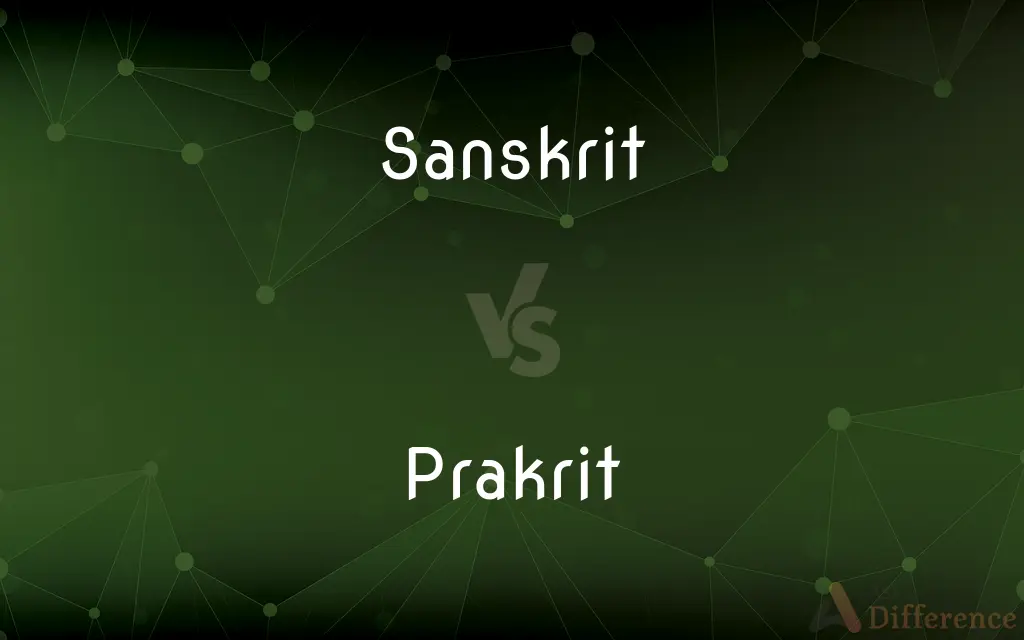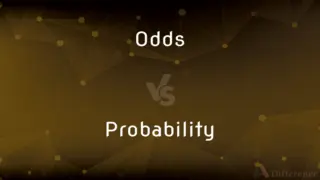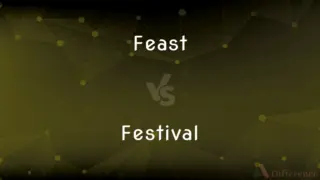Sanskrit vs. Prakrit — What's the Difference?
By Tayyaba Rehman — Updated on October 30, 2023
Sanskrit is an ancient classical language of India, while Prakrit represents a group of middle Indo-Aryan vernacular languages.

Difference Between Sanskrit and Prakrit
Table of Contents
ADVERTISEMENT
Key Differences
Sanskrit is the liturgical and classical language of India, revered for its structure, grammar, and extensive literature. Prakrit, on the other hand, encompasses various vernacular languages spoken in ancient and medieval India, more accessible to the common populace.
While Sanskrit has always held a sacred and scholarly position, being the language of Vedic texts, epics, and many philosophical treatises, Prakrit is seen in the context of popular literature, such as plays and poetry, reflecting day-to-day life and expressions.
Grammatically, Sanskrit is more complex with a robust set of rules. Prakrit, in contrast, offers simplified grammar and syntax, making it easier to learn and speak.
The use of Sanskrit was predominantly in religious, academic, and formal settings, marking its elite status. Prakrit was the spoken language of the masses and found its voice in secular contexts.
Historically, Sanskrit saw its peak during the Vedic period and later evolved, giving birth to various dialects and languages, including the Prakrits. Prakrit languages, meanwhile, evolved over time, further branching into local vernaculars that laid the foundation for many modern Indian languages.
ADVERTISEMENT
Comparison Chart
Origin
Ancient classical language of India
Middle Indo-Aryan vernacular languages
Usage
Liturgical, scholarly, and classical literature
Popular literature and daily speech
Grammar Complexity
Highly complex with robust rules
Simplified grammar and syntax
Context
Religious, academic, and formal
Secular and day-to-day communication
Historical Evolution
Predominant during Vedic period
Evolved from Sanskrit and further branched out
Compare with Definitions
Sanskrit
The liturgical language of Hinduism and Buddhism.
Mantras in Hindu rituals are often chanted in Sanskrit.
Prakrit
A group of middle Indo-Aryan vernacular languages.
Plays by Kalidasa sometimes featured characters speaking in Prakrit.
Sanskrit
An ancient Indo-European language of India.
The Bhagavad Gita was originally written in Sanskrit.
Prakrit
Offers simpler grammar than Sanskrit.
Prakrit, with its simplified syntax, was more accessible to the masses.
Sanskrit
A structured language with intricate grammar.
Students of Sanskrit often marvel at its linguistic complexity.
Prakrit
Spoken by the common people in ancient India.
While the elite conversed in Sanskrit, the commoners spoke in Prakrit.
Sanskrit
The root language for many modern Indian languages.
Many words in Hindi are derived from Sanskrit.
Prakrit
Found in popular and secular literature.
Many ancient Indian plays employed Prakrit to depict everyday life.
Sanskrit
Associated with India's philosophical and scholarly texts.
Indian philosophy, expounded in Sanskrit texts, delves deep into existential questions.
Prakrit
A precursor to several modern Indian languages.
Languages like Marathi and Gujarati have roots in Prakrit.
Sanskrit
Sanskrit (; attributively संस्कृत-, saṃskṛta-; nominally संस्कृतम्, saṃskṛtam, IPA: [ˈsɐ̃skr̩tɐm]) is a classical language of South Asia belonging to the Indo-Aryan branch of the Indo-European languages. It arose in South Asia after its predecessor languages had diffused there from the northwest in the late Bronze Age.
Prakrit
The Prakrits (; Early Brahmi ???????, prākṛta; Devanagari Sanskrit: प्राकृत, prākṛta; Shauraseni: ????, pāuda; Jain Prakrit: pāua; Kannada: pāgada) are a group of vernacular Middle Indo-Aryan languages used in India from around the 3rd century BCE to the 8th century CE. The term Prakrit is usually applied to the middle period of Middle Indo-Aryan languages, excluding earlier inscriptions and the later Pali. The Prakrits were used contemporaneously with the Classical Sanskrit of higher social classes.
Sanskrit
An ancient Indic language that is the language of Hinduism and the Vedas and is the classical literary language of India.
Prakrit
Any of the vernacular and literary Indic languages recorded from the third century BC to the fourth century AD, as opposed to Sanskrit.
Sanskrit
The ancient language of the Hindoos, long since obsolete in vernacular use, but preserved to the present day as the literary and sacred dialect of India. It is nearly allied to the Persian, and to the principal languages of Europe, classical and modern, and by its more perfect preservation of the roots and forms of the primitive language from which they are all descended, is a most important assistance in determining their history and relations. Cf. Prakrit, and Veda.
Prakrit
Any of the modern Indic languages.
Sanskrit
Of or pertaining to Sanskrit; written in Sanskrit; as, a Sanskrit dictionary or inscription.
Prakrit
Any one of the popular dialects descended from, or akin to, Sanskrit; - in distinction from the Sanskrit, which was used as a literary and learned language when no longer spoken by the people. Pali is one of the Prakrit dialects.
Sanskrit
(Hinduism) an ancient language of India (the language of the Vedas and of Hinduism); an official language of India although it is now used only for religious purposes
Prakrit
Any of the modern Indic languages
Prakrit
Any of the vernacular Indic languages of north and central India (as distinguished from Sanskrit) recorded from the 3rd century BC to the 4th century AD
Common Curiosities
Were Sanskrit and Prakrit spoken simultaneously?
Yes, while Sanskrit was more scholarly, Prakrit was the vernacular of the common people.
Why is Sanskrit's grammar considered complex?
Sanskrit has a rich structure with eight grammatical cases, intricate verb forms, and precise rules.
Is Sanskrit the mother of all Indian languages?
Not all, but Sanskrit is the precursor to many Indo-Aryan languages, and Prakrits played a significant intermediary role.
Are Prakrit languages still spoken today?
Directly, no, but they evolved into various regional languages spoken in India today.
How old is Sanskrit?
Sanskrit dates back over 3,500 years, with its earliest form found in Vedic scriptures.
Can I find Prakrit in any religious texts?
Jain scriptures are primarily written in Prakrit.
Was Sanskrit only restricted to the elites?
Historically, Sanskrit was the language of scholarship and rituals, often associated with the learned and elite.
Can I learn Sanskrit today?
Absolutely, there are many institutions and online resources dedicated to teaching Sanskrit.
Why is Sanskrit considered a sacred language in India?
It's the language of ancient sacred texts like the Vedas, Upanishads, and other spiritual scriptures.
How do Sanskrit and Prakrit influence modern Indian languages?
Many modern Indian languages have roots in Sanskrit and Prakrit, inheriting vocabulary, grammar, and structure.
Are there any famous works in Prakrit?
Yes, many ancient Indian plays and poetry are written in Prakrit.
Is Sanskrit only relevant to India?
While rooted in India, Sanskrit's literature, philosophy, and linguistic structure have garnered global interest and study.
Were there multiple forms of Prakrit?
Yes, there were several Prakrit languages like Shauraseni, Magadhi, and Ardhamagadhi.
Is Sanskrit a dead language?
While not spoken as a common language, Sanskrit is still studied, revered, and used in religious contexts in India.
Is Prakrit derived from Sanskrit?
Yes, Prakrit languages evolved from Sanskrit and later gave rise to various regional languages.
Share Your Discovery

Previous Comparison
Odds vs. Probability
Next Comparison
Feast vs. FestivalAuthor Spotlight
Written by
Tayyaba RehmanTayyaba Rehman is a distinguished writer, currently serving as a primary contributor to askdifference.com. As a researcher in semantics and etymology, Tayyaba's passion for the complexity of languages and their distinctions has found a perfect home on the platform. Tayyaba delves into the intricacies of language, distinguishing between commonly confused words and phrases, thereby providing clarity for readers worldwide.














































